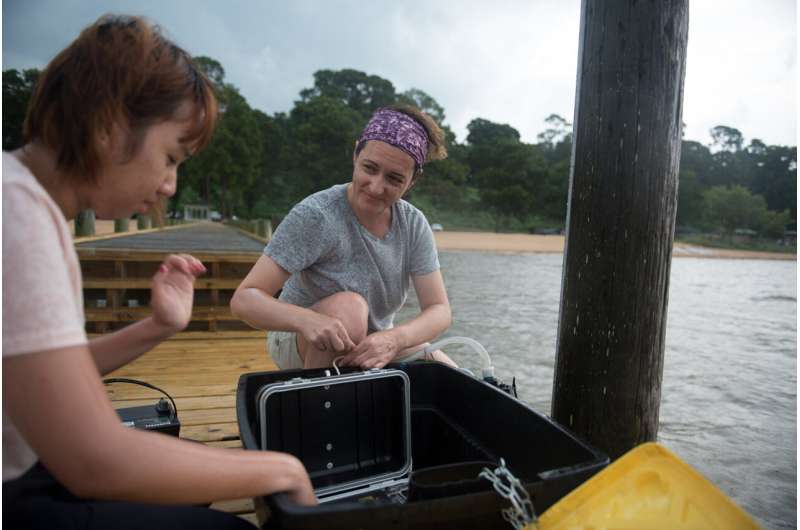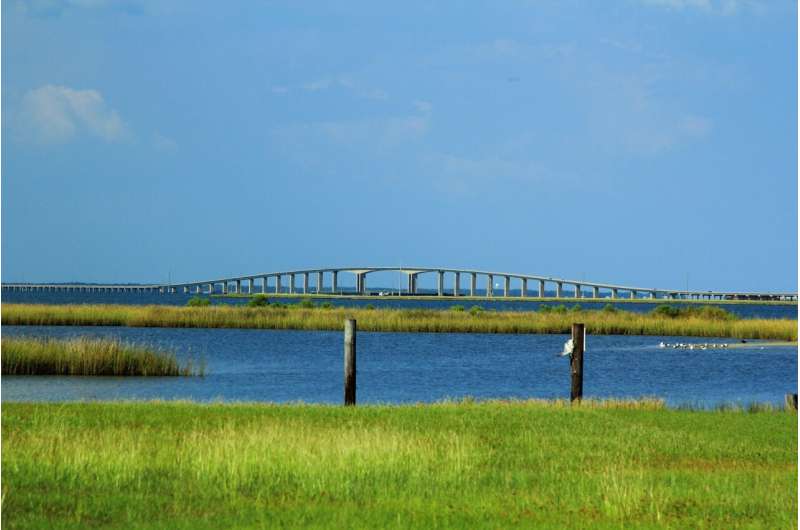From left, Dini Adyasari and Dr. Natasha Dimova check monitoring stations that detect the properties of groundwater just after discharge. Credit: University of Alabama in Tuscaloosa
Coastal areas are popular places to live and visit. Every summer, families load up their cars and head to the beach for a few days of relaxation. In Alabama, one destination is Dauphin Island, a small barrier island three miles south of Mobile Bay.
When tourists arrive, they cross their fingers for good weather. All too often, though, storms show up.
Not only can vacations be disturbed, but the waters around Dauphin Island can see an increase in groundwater and nutrients after heavy rains. Researchers from The University of Alabama recently published a paper in the journal Frontiers in Marine Science-Coastal Ocean Processes detailing how those storm events affect the marine ecosystem around barrier islands.
"It's interesting based on several factors," said Dr. Dini Adyasari, a postdoctoral researcher in geological sciences. "Dauphin Island is an urbanized island and a tourist destination, so there's a potentially high amount of nutrients or other pollutant concentration in the groundwater."
The island is also located close to the Mobile Bay Estuary, where fresh water from the Mobile River mixes with salt water from the Gulf of Mexico. When you add groundwater from Dauphin Island, it creates a hydrologically complex environment.
Over the course of 40 days, a team of UA researchers used radon and radium isotopes as tracers to evaluate the temporal and spatial variability of fresh and recirculated submarine groundwater discharge. During this period, they experienced two significant storm events on the island. What they discovered was during and immediately after the storms, the coastal water surrounding it became a river-dominated environment.
Approximately a week later, submarine groundwater discharge was almost three times higher than a few days earlier.
"This may affect the coastal water quality because rivers bring oxidized nitrogen while groundwater brings a high concentration of reduced nitrogen, which is ammonia," said Adyasari.
An influx of these groundwater nutrients can lead to an increased chance of hypoxia, or low levels of oxygen, during this time.
Dauphin Island Bridge. Credit: University of Alabama in Tuscaloosa
"Groundwater is anoxic, so it definitely plays a role in developing hypoxia in the surface water and is associated with fish kill," said Dr. Natasha Dimova, an associate professor of geological sciences and environmental geochemist.
In hypoxic waters, marine life dies and sinks to the gulf floor, leading to further oxygen reduction. The increased groundwater nutrients can create and sustain harmful algal blooms, resulting in more problems for coastal communities.
"They cause respiratory issues for people," said Dr. Behzad Mortazavi, professor and chair of UA's Department of Biological Sciences. "They also close the beaches, and it can lead to the closure of shellfish harvest and similar situations, so that kind of impact is very real and local."
At Dauphin Island, the team discovered how variable the nitrogen levels were in two separate locations. The first area next to a pier had reduced nitrogen, which Adyasari believes is naturally occurring due to the native sediments through which groundwater flows. At the second location near a golf course, they discovered a much higher concentration of nitrate, which is potentially from the fertilizer used to maintain the field.
During dry times, surface water pools and infiltrates the ground, bringing nitrates found in substances such as fertilizer into the groundwater. As it seeps down into the subsurface, biogeochemical reactions can change the nitrate into nitrogen gas, causing it to dissipate and reduce the impact on groundwater.
However, barrier islands offer a unique challenge in filtering these contaminants because of their susceptibility to storm events.
"They are piles of sand that have been pushed around through hurricane events, so the groundwater residence time in the subsurface is very short," said Dimova. "It flushes out like a toilet, so there's not a lot of time for these chemical changes and filtration in the subsurface."
Studying these dynamics is crucial to learn how barrier islands contribute to groundwater discharge during storm events. Dimova hopes they can spend more time on these islands to easily access monitoring stations and see how the waters react to storms in different seasons throughout the year.
"Seeing the huge benefit of the continuous records, our future research directions are obtaining measurements for longer periods and at multiple locations," she said. "If we can get more of those continuous interrupted records, we would understand these systems better, we can do much better predictions and we can model these systems, especially using the modern tools of artificial intelligence."
Expanding these studies and public knowledge will allow residents and visitors to become more aware of how sensitive barrier islands are to precipitation and how nutrients transported by groundwater can impact the local economy. They will create a better understanding for improving coastal water quality, groundwater quality and quantity for future freshwater resources in similar areas around the world.
More information: Dini Adyasari et al, Storm-Driven Fresh Submarine Groundwater Discharge and Nutrient Fluxes From a Barrier Island, Frontiers in Marine Science (2021). DOI: 10.3389/fmars.2021.679010
Journal information: Frontiers in Marine Science
Provided by University of Alabama in Tuscaloosa

























